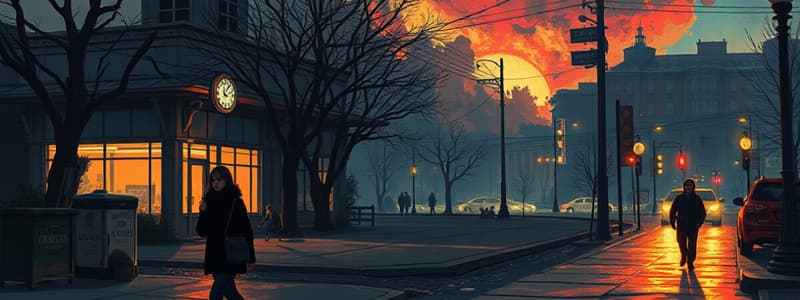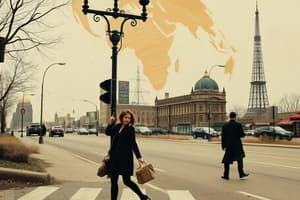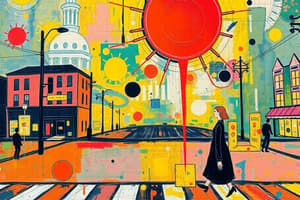Podcast
Questions and Answers
What does Mr. Leonard Mead enjoy doing in the city?
What does Mr. Leonard Mead enjoy doing in the city?
- Reading in a café
- Walking alone (correct)
- Riding a bicycle
- Driving fast
Mr. Mead encounters many people during his walks.
Mr. Mead encounters many people during his walks.
False (B)
What does Mr. Mead hear while walking that brings satisfaction to him?
What does Mr. Mead hear while walking that brings satisfaction to him?
The faint push of his soft shoes through autumn leaves.
Mr. Mead often prefers to wear _______ while strolling at night to avoid making noise.
Mr. Mead often prefers to wear _______ while strolling at night to avoid making noise.
What does Mr. Mead whisper to the houses as he walks by?
What does Mr. Mead whisper to the houses as he walks by?
Match the descriptions with their corresponding imagery in Mr. Mead's environment:
Match the descriptions with their corresponding imagery in Mr. Mead's environment:
The city in November is described as misty and quiet.
The city in November is described as misty and quiet.
What direction does Mr. Mead start his journey on this particular evening?
What direction does Mr. Mead start his journey on this particular evening?
What was Leonard Mead's profession?
What was Leonard Mead's profession?
Leonard Mead was married.
Leonard Mead was married.
What time was it when Leonard Mead checked his wristwatch?
What time was it when Leonard Mead checked his wristwatch?
Leonard Mead was walking for ______, to see, and just to walk.
Leonard Mead was walking for ______, to see, and just to walk.
Match the following elements with their descriptions:
Match the following elements with their descriptions:
How many police cars were left in the city?
How many police cars were left in the city?
Leonard Mead has successfully published many books recently.
Leonard Mead has successfully published many books recently.
What does the police car accuse Leonard Mead of?
What does the police car accuse Leonard Mead of?
Leonard Mead's house is located at ______ South Saint James Street.
Leonard Mead's house is located at ______ South Saint James Street.
What happens to the back door of the police car after Mead's conversation?
What happens to the back door of the police car after Mead's conversation?
The atmosphere in Leonard Mead's neighborhood is vibrant and bustling with people.
The atmosphere in Leonard Mead's neighborhood is vibrant and bustling with people.
Where does the police car take Leonard Mead?
Where does the police car take Leonard Mead?
Leonard Mead felt like a night moth, stunned by the ______.
Leonard Mead felt like a night moth, stunned by the ______.
What kind of street environment does Leonard Mead encounter during his night walks?
What kind of street environment does Leonard Mead encounter during his night walks?
The police car had visible police officers inside.
The police car had visible police officers inside.
Flashcards are hidden until you start studying
Study Notes
Setting and Atmosphere
- The story takes place in a misty evening in November, 2053 A.D., in a silent and desolate city.
- The concrete walk is described as buckling, indicating neglect and disuse.
- The environment is cold with a crystal frost, creating a stark and inhospitable ambiance, reminiscent of a graveyard.
Main Character: Mr. Leonard Mead
- Leonard Mead deeply enjoys solitary night walks, symbolizing his alienation in a technologically advanced society.
- He is depicted as reflective, taking notice of homes with dark windows, which suggests a disconnect between individuals and communal life.
- Prefers soft shoes to avoid disturbing the silence, previously changed from hard heels due to canine disturbances.
The Walk
- His walks are extensive, often returning home at midnight after covering hours and miles.
- Mead's imagination leads him to envision vast, empty plains during his strolls, highlighting his isolation.
- As he walks, he engages in playful thoughts about the shows airing in the homes he passes, contrasting his experiences with the life of those inside.
Police Encounter
- Mead's solitary existence is interrupted when a police car shines a spotlight on him, a rare occurrence in a city where crime has diminished.
- The car symbolizes an oppressive authority, questioning the need for a police presence in such an empty urban landscape.
- The dialogue showcases the absurdity of social norms in a future where personal freedom is suspicious.
Themes of Isolation and Technology
- Technology is presented as a tool for enforced conformity; people remain indoors, engrossed in screens, living almost like the dead.
- Mead longs for genuine human connection and experiences, contrasting sharply with the isolated lifestyles driven by technology.
- His profession as a writer is rendered obsolete, emphasizing a cultural shift away from creativity to passive entertainment.
Final Events
- Mead's non-threatening response to the police questioning leads to his arrest for being out and "different" in a conformist world.
- The police car represents a dehumanizing force, taking him to the "Psychiatric Center for Research on Regressive Tendencies" for simply being an individual.
- The narrative concludes as the police car drives away, leaving the city volatile and devoid of life and sound, reinforcing the themes of alienation.
Studying That Suits You
Use AI to generate personalized quizzes and flashcards to suit your learning preferences.




